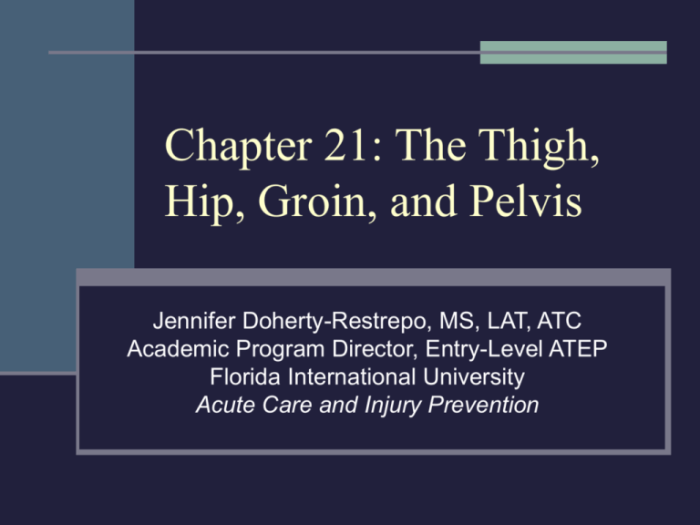Chapter 17 worksheet the thigh hip groin and pelvis – Embark on a journey through Chapter 17’s worksheet, where the intricate anatomy of the thigh, hip, groin, and pelvis unravels. Delve into the skeletal structure, muscular composition, movements, functions, and potential injuries associated with this fascinating region.
From understanding the range of motion to exploring common ailments and rehabilitation strategies, this worksheet provides a comprehensive overview of the musculoskeletal system’s lower extremities. Prepare to gain invaluable insights into the human body’s mechanics and the importance of maintaining optimal health.
Musculoskeletal Anatomy of the Thigh, Hip, Groin, and Pelvis

The thigh, hip, groin, and pelvis form a complex musculoskeletal system that enables mobility, stability, and support for the lower body. Understanding their intricate anatomy is crucial for comprehending their functions and addressing potential injuries or conditions.
Skeletal Structure
The skeletal framework of this region consists of the:
- Femur: The longest bone in the body, forming the thigh bone
- Patella: The kneecap, located anteriorly to the femur
- Pelvis: A bony ring composed of the ilium, ischium, and pubis, providing support and attachment for muscles
- Acetabulum: A socket-like structure within the pelvis that articulates with the femur, forming the hip joint
Muscular Composition
Numerous muscles contribute to the movements and functions of this region, including:
- Quadriceps: A group of four muscles on the anterior thigh, responsible for knee extension
- Hamstrings: A group of three muscles on the posterior thigh, involved in knee flexion
- Gluteus maximus: A large muscle on the buttocks, extending the hip and stabilizing the pelvis
- Adductor muscles: Located on the inner thigh, they adduct (bring together) the thighs
- Abductor muscles: Found on the outer thigh, they abduct (move apart) the thighs
Movements and Functions of the Thigh, Hip, Groin, and Pelvis

The thigh, hip, groin, and pelvis enable a wide range of movements essential for daily activities:
Thigh
- Flexion: Bending the knee
- Extension: Straightening the knee
- Internal rotation: Turning the leg inward
- External rotation: Turning the leg outward
Hip, Chapter 17 worksheet the thigh hip groin and pelvis
- Flexion: Bringing the thigh towards the chest
- Extension: Moving the thigh backward
- Abduction: Moving the thigh away from the midline
- Adduction: Moving the thigh towards the midline
- Internal rotation: Turning the thigh inward
- External rotation: Turning the thigh outward
Groin
- Adduction: Bringing the thighs together
- Abduction: Moving the thighs apart
Pelvis
- Tilting: Forward, backward, or side-to-side
- Rotation: Clockwise or counterclockwise
- Nutation: Upward movement of the sacrum
- Counternutation: Downward movement of the sacrum
Frequently Asked Questions: Chapter 17 Worksheet The Thigh Hip Groin And Pelvis
What is the primary function of the hip joint?
The hip joint facilitates a wide range of movements, including flexion, extension, abduction, adduction, and rotation. It plays a crucial role in supporting the body’s weight and enabling locomotion.
What are some common injuries associated with the groin area?
The groin region is susceptible to various injuries, such as groin strains, hernias, and osteitis pubis. These injuries often result from excessive force or repetitive movements and can cause pain, discomfort, and mobility limitations.
How can I prevent injuries to the thigh, hip, groin, and pelvis?
To minimize the risk of injuries, it is essential to engage in regular stretching and strengthening exercises, maintain a healthy weight, and use proper techniques when lifting heavy objects or performing physical activities.

